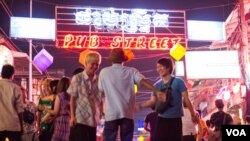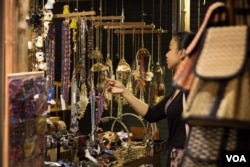More than 2 million tourists visit the city of Siem Reap and nearby temples of Angkor Wat each year. But for vendors and other businesses here, that means more and more competition. For many, the bottom line is that they make less money, despite the continued flow of tourism.
Outside the Kravan Temple, book seller Srey Neang, 17, said she had been doing this for seven years, and in that time, the price people are willing to pay her per book has been cut in half, from $2 to $1. “I sell less stuff than before,” she said. “And I can’t sell them for as high a price.”
Meanwhile, the number of vendors has increased, from about four around the temple to 10, she said.
In and around the famed temples, crowded with hawkers for books, jewelry and other trinkets, many tell the same story. And that goes for the town of Siem Reap, as well.
Mabendra Amarasinque, the owner of an Indian restaurant along the bustling Pop Street, said the arrival of tourists continues, year by year, but the number of restaurants is growing. “Now they’re everywhere,” he said. “The customers are spread everywhere. We’ve got less customers.”
Amarasinque said he’s had to lower his prices, even though costs of his ingredients and spices are more. “Now they have tourist-style food for tourists,” he added.
Kong Sophearak, the Ministry of Tourism’s director of statistics and information, said more tourists are coming to Cambodia—about 4.5 million in 2014, compared to 4.2 million the year before. They spend most of their money on accommodation, though shopping, food and travel are all a part of it too. In Siem Reap, the number increased slightly, from 2.23 million in 2013 to 2.35 million in 2014.
Ho Vandy, co-chair of the Government-Private Sector Working Group, said tourist spending is getting spread across more and more vendors and businesses, decreasing profits.
Not everyone is losing out, however. Some vendors have found ways to capitalize on the bustle. Uy Sopheak, who sells clothes to tourists at Bantey Kdei temple, is lucky. She said she’s found ways to increase her sales, from $3 to $4 a day, to $50 a day now.
“Now there are many tourists,” she said. “Even Russians are coming. Malaysia too. Before, we did not have Malaysians.”
Still, for many, the high number of vendors has meant trouble.
On Pop Street, where tourists hang out for drinks and food and shopping after a day at Angkor Wat, many sellers vie for dollars. Watching tourists stroll past her fruit shake cart recently, Srey Roth, 23, said she’s seen a huge decrease in business. “Before I could sell from 70 to 80 shakes, but these days I sell only about 30 glasses,” she said. “It’s quiet.”










